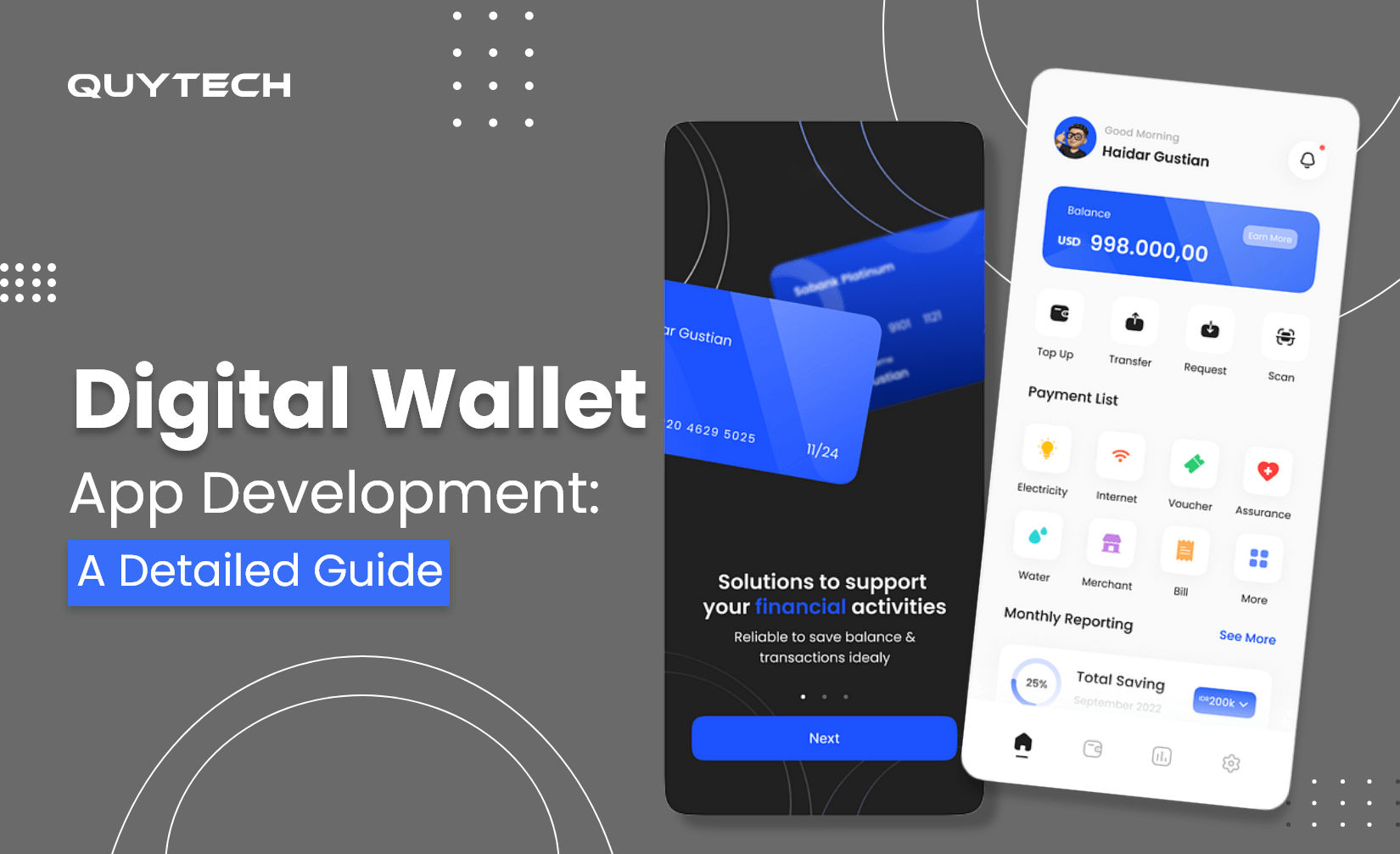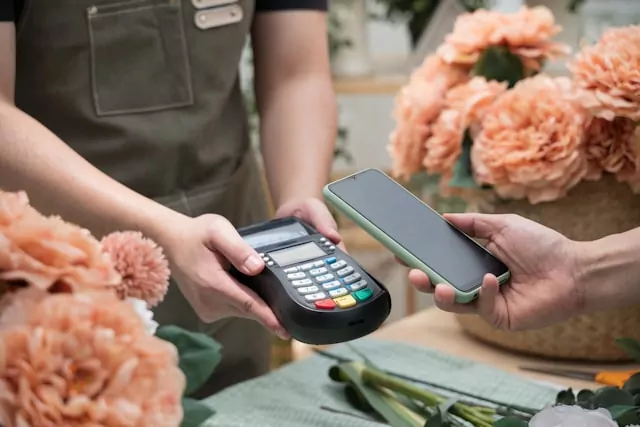People are ditching traditional physical wallets which were used to store money, cards, IDs, and more, and are switching to digital wallets, also known as e-wallets.
These digital wallets are not stored in pockets but instead in smartphones, tablets, and other devices, in the form of an app.
In 2022, there were 3.4 billion users who used digital wallets. It is expected that the number will grow by 53% to reach 5.2 billion by 2026.
The major reason for the increasing adoption of electronic wallets is the ease of use, the shift towards online payments, and high security compared to physical wallets, which reduces the risk of being stolen and misused.
Analyzing the growing adoption, entrepreneurs find this a huge investment opportunity to build digital wallets that cater to new and existing users and generate revenue.
But, one thing that is holding them back from executing the plan is a lack of knowledge to develop a digital wallet. So, we curated a detailed guide to developing a digital wallet app to give entrepreneurs the knowledge required for successful development.
Digital Wallet Applications Market Statistics
The following are some statistics showing the market of digital wallet applications.
Source: Precedence Research
- The global mobile wallet market is projected to be valued at approximately $88.36 billion by 2033, expanding at a CAGR of 27.20% from 2024 to 2033.
- A survey reveals that approximately 53% of Americans use digital wallets more than traditional payment methods.
- By 2027, digital wallets are expected to make up for 46% of POS (Point of Sale) expenditure, or $19.6 trillion, surpassing credit and debit cards altogether.
- According to Juniper Research, the overall value of digital wallet transactions will grow from $9 trillion in 2023 to $16 trillion in 2028, representing a 77% increase.
- Apple Pay, Google Pay, Samsung Pay, Venmo, Paypal, and CashApp are some popular digital wallets in the United States of America.
These statistics clearly show that digital wallet usage will exponentially increase in the coming years. Hence, it is the right time to invest in digital wallet app development and capitalize on this amazing business opportunity.
What are Digital Wallets?
Digital wallets are mobile applications that are used to make payments. In other words, it’s like a physical wallet you use to carry money and make payments, but in a digital form.
Using digital wallets, one can make payments, pay bills, make P2P (peer-to-peer) money transfers, and more, securely. Moreover, these apps can also be used to store identity cards, loyalty cards, visiting cards, membership cards, etc., in a digital form.
Types of Digital Wallets
Before moving on to the development process, let’s understand the types of digital wallets. There are five main types of digital wallets, which are as follows:
- Closed Wallets
The closed digital wallets are designed to make transactions between the users and the wallet provider. In other words, these types of wallets can be used to make payments to a particular entity.
For example: Amazon Pay, which is used to buy products and services provided by Amazon.
- Semi-Closed Wallets
The semi-closed wallets are developed to allow users to make payments with multiple merchants, who have an agreement with the wallet issuer. Users cannot make payments outside the network using a semi-closed digital wallet.
For example: Venmo is used to make payments to partnered merchants only.
- Open Wallets
Open digital wallets are developed for the broadest usage, such as making payments, transferring funds, and withdrawing cash from cardless ATMs. These open wallets are issued by banks or their partners.
For Example: Apple Pay and Google Pay are used to pay at numerous merchants, peer-to-peer payments, and more.
- Cryptocurrency Wallets
As the name suggests, cryptocurrency wallets are used to store, manage, send, and receive, digital cryptocurrencies like Bitcoin, Ethereum, USDT, Binance, and more.
For Example: Coinbase, Ledger, and MetaMask are wallets that provide secure storage and allow transactions of various cryptocurrencies.
- IoT Wallets
These types of digital wallets are developed particularly for the Internet of Things (IoT) ecosystem to facilitate transactions between IoT-driven devices.
For Example: IoT wallets are used in smart cars for automatic toll or gas station payments
Now that you have known the types of e-wallets, let’s move on to the process of developing a custom digital wallet.
Step-by-Step Process to Build a Digital Wallet App
The following is the step-by-step process to develop a custom digital wallet application tailored to your specific requirements.
Step#1. Determine the Project Goals
The foremost step to building a digital wallet app is to determine the purpose behind developing it and its core functionalities.
Does your digital wallet will be used only to make payments, or can also be used to store cryptocurrencies? Will it be a closed wallet or an open wallet? You should be well aware of the goal of building a digital wallet.
Step#2. Set Up the Development Team
Fintech app development requires a deep understanding of how finance works, various regulations, extensive expertise in app development, and more.
So, it will be a good idea to set up a development team by hiring top app developers who have experience and expertise in developing digital wallets.
Another proven option is to outsource the project to a leading fintech app development company.
Step#3. Wireframing and Prototyping
Start with creating the wireframe and prototypes for the digital wallet. Make rough sketches of how the application will look, its tabs, icons, features, and more.
Moving forward, create interactive and functional app models to simulate how the final product will work.
Step#4. UI/UX Designing
The next step is to design the user interface (UI) for the digital wallet. Create the visual elements of the app, such as layouts, color schemes, icons, and overall aesthetics, to offer an enhanced user experience (UX).
Step#5. Develop the App
After designing, start developing the digital wallet’s core backend infrastructure. Use frameworks like Flutter and React Native to create a digital wallet, compatible with various platforms and screen sizes.
Moreover, integrate cutting-edge features and functionalities to improve the user experience and gain a competitive advantage.
You can also leverage artificial intelligence, generative AI, blockchain, machine learning, and more, to enhance the functionalities of the digital wallet.
Also, high-end security measures should be added to protect user data and make transactions secure and safeguarded from unauthorized access and cyber-attacks.
Step#6. Testing and Quality Assurance
Test the digital wallet on different devices and platforms to ensure it is working as expected. Identify bugs and glitches and fix them before the launch.
Moreover, you can also opt for Beta Testing and launch the digital wallet app in a closed environment. By doing so, you can gather user feedback and make relevant changes recommended by users before launching it in the market.
Step#7. Launch the Wallet App
Launch the e-wallet for the general public use. Publish the app on Google Play Store and App Store, following their guidelines.
Also, use marketing strategies like app store optimization, advertisements, SEO, and influencer marketing to market your digital wallet.
Step#8. Post-Launch Maintenance
The mobile wallets require regular updates and bug fixing to ensure consistent and smooth functioning. Hence, it is recommended to monitor the app’s performance using various KPIs (key performance indicators).
Also, upgrade the app version, make slight changes in UI designs, and add new functionalities to give your users a whole new experience.
So, this is how you can develop a custom digital, or e-wallet, app tailored to your specific needs. If you want professional assistance, reach out to our team and we will develop the wallet app as per your requirements.

Technology Stack to Develop an E-Wallet App
You will need app development tools and technologies to develop a digital wallet application. So, here we have provided a technology stack you can use to build a mobile wallet app.
| Component | Technology Stack | Description |
| Frontend Development | Frameworks: React Native, Flutter Languages: JavaScript, Dart |
– For building cross-platform mobile interfaces. – Used for writing frontend code. |
| Backend Development | Frameworks: Express.js, Django, Spring Boot Languages: Node.js, Python, Java |
– Frameworks for building and managing server-side applications.
– For server-side logic and API development. |
| Database | SQL Databases: PostgreSQL, MySQL NoSQL Databases: MongoDB, Firebase |
– For structured data storage and management. – For handling unstructured data and real-time updates. |
| Authentication | Services: OAuth, JWT, Firebase Authentication | For user authentication and secure access management. |
| Payment Integration | APIs: Stripe, PayPal, Braintree | For processing payments and transactions. |
| Security | Tools: SSL/TLS, AES Encryption | For secure data transmission and storage. |
| Cloud Services | Providers: AWS, Google Cloud, Azure | For scalable infrastructure, hosting, and storage. |
| Monitoring & Analytics | Tools: Google Analytics, New Relic, Datadog | For tracking performance, usage, and errors. |
| DevOps | Tools: Docker, Jenkins, Kubernetes | For continuous integration, deployment, and container management. |
| Testing | Tools: Selenium, Appium, JUnit | For automated testing of functionality and performance. |
* Please note that this technology stack is for recommendation purposes only. You can use other tools and technologies that align with your specific requirements.
Top Features to Integrate into a Digital Wallet
The following are the best features to add while developing a custom digital or e-wallet. Here, we have categorized them into must-haves and advanced features.
Must-Have Features
- User Registration and Authentication
Provide secure sign-up and login processes with two-factor authentication for additional security. Users can log in using their phone numbers, email addresses, or social media accounts.
- Account Management
A feature to allow users to manage their digital wallet accounts. Using this feature, they can update personal information, link bank accounts, manage cards, and more.
- Fund Transfers
A simple and secure feature to allow users to make peer-to-peer (P2P) payments, transfers to bank accounts, and international payments. Users can also make in-store payments by scanning QR codes or using NFC (near-field communication).
- Transaction History
Thanks to the transaction history feature, users can access their detailed transaction lists. They also get search and filter options and options for downloadable statements for their records.
- Bill Payments
A user-friendly feature to allow users to pay bills for electricity, water, gas, mobile recharges, membership renewals, and more.
- Security Features
Data encryption and secure socket layer (SSL) protocols and fraud detection and prevention mechanisms to make the mobile wallet more secure and win users’ trust.
- Notifications and Alerts
A must-have feature for a digital wallet so that users can receive real-time notifications for transactions and account-related activities.
- Customer Support
An in-app customer support chatbot powered by generative AI to address user grievances around the clock.
Advanced Features
- Loyalty and Rewards Programs
A feature to reward users who often use your digital wallet. You can give them cashback, reward points, and loyalty programs which can be redeemed while buying other products.
- Expense Tracking and Budgeting
AI-powered expense categorization and tracking tool to help users keep track of their finances.
- Voice-Driven Payments
An e-wallet’s feature to make payments and perform other activities, like checking account balances, using voice commands.
- Investment Options
Another intuitive feature allows users to explore investment options like mutual funds, bonds, stocks, and more.
- Offline Access
Allows users to make payments and money transfers without the Internet.
- Multi-Currency Support
Digital wallet’s feature that empowers users to handle multiple currencies, and convert currencies in real-time, within the app.
Adding these features in the digital wallet app not only gives your users a new experience but also helps you get a competitive edge in the market.
Cost to Develop a Custom Digital Wallet App
It is difficult to give you an exact cost to build a digital wallet application as its development cost depends on multiple factors. The top factors that influence the costs are as follows:
- Features and functionalities
- Development team size and location, and more.
Hence, we recommend you to get in touch with our experts and share your requirements.
Our experts will analyze your requirements and based on the above-mentioned factors, they will quote you the exact cost of developing a custom e-wallet application tailored to your needs.
Factors to Keep in Mind For Building a Digital Wallet App
For building a successful e-wallet application, you should keep the following factors in mind:
- Security
Security is the most crucial factor to consider while developing an e-wallet app. Hence, you must implement robust encryption, secure authentication methods, and fraud detection mechanisms, so that you can protect user data and transactions, and win the trust of the users.
- User Experience (UX)
You should focus on providing an enhanced user experience for using your digital wallet app. To do so, you must design an intuitive and user-friendly interface that ensures effortless navigation and allows for conducting smooth transactions.
- Compliance
Fintech app development must comply with various regulations and industry standards. Therefore, while developing the mobile wallet application, focus on adhering to regulatory standards and industry compliance requirements, such as PCI-DSS for payment security and GDPR for data protection.
- Scalability
Digital wallet apps tend to scale as new users come on board and transaction volumes increase exponentially. So, you must be ready to allow your app to scale by building a scalable architecture that can handle increasing user loads and transaction volumes efficiently.
- Transaction Speed
Nobody likes slow transactions. Instead, users highly appreciate swift transaction experiences that take only a couple of seconds. Therefore, it is necessary to optimize for fast transaction processing while building a digital wallet to enhance user satisfaction and reduce wait times.
- Cost and Fees
Another factor to consider for developing a mobile wallet is to be transparent about the costs or fees you will charge for transactions, card linking, account maintenance, and any other purposes.
- Backup and Recovery
Last but not least, add features for data backup and recovery in your digital wallet so that users can get back their data and transaction history if they lost their device or their device malfunctioned.
Conclusion
The world is shifting towards online payments. This is because online payments are fast and more secure when compared to traditional offline payments. And to facilitate these online transactions, digital wallets play a key role.
This is why many leading fintech app development companies are building custom digital wallets loaded with the best features and high-end technologies to give users seamless online payment experiences.
If you also want to develop a custom digital wallet tailored to your specific needs reach out to Quytech. We are the top finance app development company with years of experience in building apps and solutions that disrupt the finance industry.
Frequently Asked Questions
Here are some FAQs related to digital wallet app development.
The world is shifting towards digital payments and the industry is growing exponentially. Hence, it is the right time to develop a digital wallet and create your space in the digital payments industry.
To build a digital wallet, you can either refer to the development guide provided in this blog or get in touch with a top fintech app development company that has expertise in developing digital wallets.
It takes approximately 4 to 11 months to create a digital wallet. However, the exact timeframe depends on the requirements of the project.
Post Views: 55





















Discussion about this post